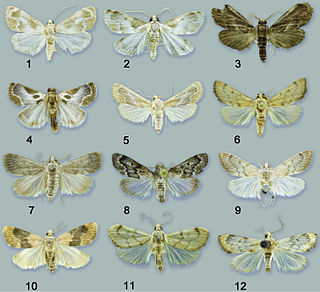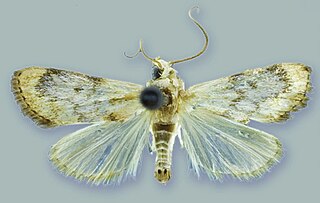Protrigonia is a monotypic moth genus of the family Crambidae erected by George Hampson in 1896. It contains only one species, Protrigonia zizanialis, described by Charles Swinhoe in 1886, which is found in Sri Lanka and western India.

Schacontia is a genus of moths of the family Crambidae described by Harrison Gray Dyar Jr. in 1914.
Hellula phidilealis, the cabbage budworm moth, is a moth of the family Crambidae. It is found in tropical and subtropical America. From the southern United States, north in the east to North Carolina, south through southwestern Mexico to northern South America, including several islands in the Caribbean.

Glyphodes bivitralis is a moth of the family Crambidae described by Achille Guenée in 1854. It is native to south-east Asia, including Hong Kong, India, Japan, Taiwan and Thailand. It is also found in Queensland, Hawaii and Maldives.

Palpita maritima is a moth in the family Crambidae. The species was first described by J. Bolling Sullivan and Maria Alma Solis in 2013. It is found in the United States in Alabama, North Carolina and Florida. The habitat consists of coastal maritime forests.

Schacontia medalba is a moth of the family Crambidae described by William Schaus in 1904. It is found in Brazil and Peru.

Schacontia chanesalis is a moth of the family Crambidae described by Herbert Druce in 1899. It is found in Mexico, Guatemala, Costa Rica and Venezuela.

Schacontia umbra is a moth of the family Crambidae described by Maria Alma Solis and Paul Z. Goldstein in 2013. It is found in central Ecuador.

Schacontia themis is a moth of the family Crambidae described by Maria Alma Solis and Paul Z. Goldstein in 2013. It is found on the Cayman Islands and in Brazil, Costa Rica, Cuba, the Dominican Republic, Florida, Jamaica, Mexico, Panama, Puerto Rico and Venezuela.

Schacontia rasa is a moth of the family Crambidae described by Maria Alma Solis and Paul Z. Goldstein in 2013. It is found in Mexico, Cuba and the Dominican Republic.

Schacontia nyx is a moth of the family Crambidae described by Maria Alma Solis and Paul Z. Goldstein in 2013. It is found in northern Venezuela.

Schacontia clotho is a moth of the family Crambidae described by Maria Alma Solis and Paul Z. Goldstein in 2013. It is found in southern Ecuador.

Schacontia lachesis is a moth of the family Crambidae described by Maria Alma Solis and Paul Z. Goldstein in 2013. It is found in central Brazil and Bolivia.

Schacontia atropos is a moth of the family Crambidae described by Maria Alma Solis and Paul Z. Goldstein. It is found in northern Venezuela.

Schacontia ysticalis is a moth of the family Crambidae described by Harrison Gray Dyar Jr. in 1925. It is found in Mexico, Costa Rica, Honduras, Nicaragua, Venezuela and Bolivia.

Glaphyriinae is a subfamily of the lepidopteran family Crambidae. It was described by William Trowbridge Merrifield Forbes in 1923. The subfamily currently comprises 509 species in 75 genera.
Nymphicula cyanolitha is a moth in the family Crambidae. It was described by Edward Meyrick in 1886. It is found on Fiji.
Nymphicula mesorphna is a moth in the family Crambidae. It was described by Edward Meyrick in 1894. It is found in Myanmar, Japan and Taiwan.
Cosmopterosis hispida is a moth in the family Crambidae. It was described by Maria Alma Solis in 2009. It is found in Brazil.
Eudonia rectilineata is a moth in the family Crambidae. It was described by Wei-Chun Li, Hou-Hun Li and Matthias Nuss in 2012. It is found in China.














